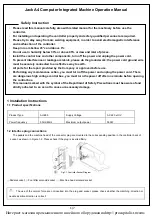
2
T
H
R
E
A
D
O
V
E
R
L
O
C
K
27
LL
LN
LN RN
LL
RN
2-Thread Overlock
Converting from 3-Thread to 2-Thread
Overlock
Either needle thread may be engaged for 2-thread
serging.
1. Open the front cover and the blade cutter, and cut
the upper looper thread just above the threading
port. (fig.A) Raise the presser foot and pull out
the clipped thread from under the foot. Remove
the upper looper thread from the machine.
2. Rotate the handwheel to bring the upper looper
into position to attach the subsidiary looper.
3. Slide the subsidiary looper to the right and swing
it counterclockwise. (fig.B)
4. Close the blade cover and the front cover,
decrease the needle tension for 2-thread serging.
(see chart on the inside back cover)
The needle and lower looper threads should
overcast evenly on the cut edge of the fabric.
Sew a test sample. Make adjustments if needed.
Refer to diagrams.
*The cutting blade cover has been removed in
photos B and C for a clear view. You do not need
to remove the cutting blade cover.
The 2-thread function provides an economical and less bulky means of overedging all fabrics.
When joining two fabrics together with 2-threads, the seam it forms is not a standard overlock
seam but a
flatlock
seam. 2-thread rolled edge creates a delicate finish on fine wovens and
smooth silkies. When sewn with specialty threads, 2-thread serging makes decorative seams
and edges for activewear, children's clothing, ruffles and hemlines.
A
1
2
B
C
Left or Right Needle Thread
Lower Looper Thread
Perfect seam
Wrong
side
UL
LL
LN
RN
UL
LL
LN
RN
Unbalanced Thread Tension
Tighten
Tighten
Loosen
Loosen
Summary of Contents for Celebrate BLS1
Page 1: ...TM Model BLS1...
Page 5: ...N O T E S 2 Notes...
















































